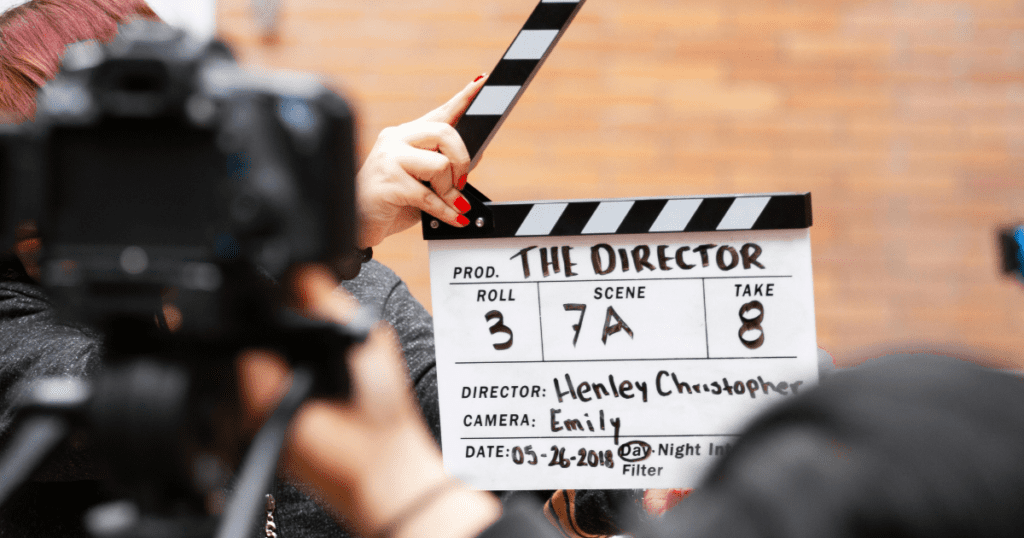Directing vs Cinematography. The director and the cinematographer play very different roles on a film set, but both of these above the line jobs are interesting and creatively fulfilling. When starting out, some people might have interest in both of these roles. People outside of the film industry might not understand the way these two people work together to create a shared vision. So today, let’s talk about directing vs cinematography; what does each role entail, how do they work together, and how can you get started in either department?
What does a director do?
The role of director is easier to understand than some other above the line creative roles on a film set. The director does exactly what the name says: they direct. If a film set was a ship, they’d be the captain, charting the course and giving the orders to the crew. The director, who is hired by producers, has a creative vision for the project, and it’s everyone else’s job–including the DP or cinematographer–to bring that vision to life.
The director starts with the script. On some productions, the director is the screenwriter as well. On other productions, they work alongside the screenwriter, or are hired to direct a completed script. Their job is to visualize the script and figure out how to bring it to life.
Directors work alongside producers and casting directors to cast actors for the script. They give input to the producers who hire the rest of the crew, including the cinematographer or DP. Once they’re on set, the director directs the whole production, giving notes to actors, asking for specific shots, giving input on lighting, and much much more.
During post production, the director works alongside the editor to create a cut of the movie called “the director’s cut.” The producers may sign off on this cut, or they may ask for changes. Sometimes, a separate director’s cut is released after the film’s “official” cut is released, so that audiences can see the edit that the director envisioned.

What does a cinematographer do?
Like the director, a cinematographer, director of photography, or DP is an above the line creative who helps choose the creative direction of the film. Also like the director, they have other people below them in the camera department that they supervise. However, this is largely where the similarities end. The cinematographer is typically hired by producers with input from the director, and their job is to bring the director’s vision to life using their unique style and skillset.
The cinematographer is responsible for capturing every single shot of the movie on camera, and they are responsible for the lighting, look, color, and composition of a scene. The director may ask for specific qualities or specific shots, and in that case it’s the cinematographer’s job to get that done. They direct lighting technicians to light the shots in the way that they believe best suits the film. Everything from the lighting to the specific angle and placement of the camera communicates something to the viewer and plays a role in bringing the director’s vision to life.
The cinematographer works alongside the director, set designer, actors, camera operators, gaffer, lighting department, and more to do this. On smaller sets, the cinematographer may also operate the camera.
How do I become a director or cinematographer?
There are many ways to become a director. First, you’ll need to decide if you want to go to film school, or if you want to learn through experience. There are pros and cons to each option. Either way, you will need to work on film sets to understand how they function before you’ll be ready to take on the role of director. Here’s a list of entry level film positions that might help you get your foot in the door.
If you’re not going to film school, take the time to learn more about the art of filmmaking. Here’s a list of filmmaking courses and a list of filmmaking ebooks. If you’re interested in being a writer/director, which is especially common in the indie scene, take the time to learn more about screenwriting, and specifically how to write a screenplay that’s easy and cheap to produce. Your first film probably won’t have the budget of a Marvel movie, so it’s good to learn more about how this works.
To become a cinematographer, you have similar options: self-taught or film school. Either way, get a camera and experiment with shooting your own videos. Watch a lot of movies and decide what you like or don’t like when it comes to cinematography. Work to learn more about color theory and shot composition.
With either role, it’s wise to do your own projects before you start charging people money. See what happens if you film a music video just for fun, or produce a short film on your own. Get some experience and find out what you really enjoy and want to accomplish with your work.

 It can
It can 









Leave a Reply